Business Environment Analysis and Sustainability
VerifiedAdded on 2020/10/22
|13
|4119
|365
AI Summary
This assignment provides an in-depth analysis of the business environment, focusing on sustainable innovation and the triple bottom line. It includes a review of key concepts such as systems thinking, business models for sustainability, and corporate social responsibility. The assignment also touches on the importance of socio-economic factors in small business success and the impact of government policies on entrepreneurship. A PESTEL analysis is conducted to identify opportunities and challenges in the business environment.
Contribute Materials
Your contribution can guide someone’s learning journey. Share your
documents today.
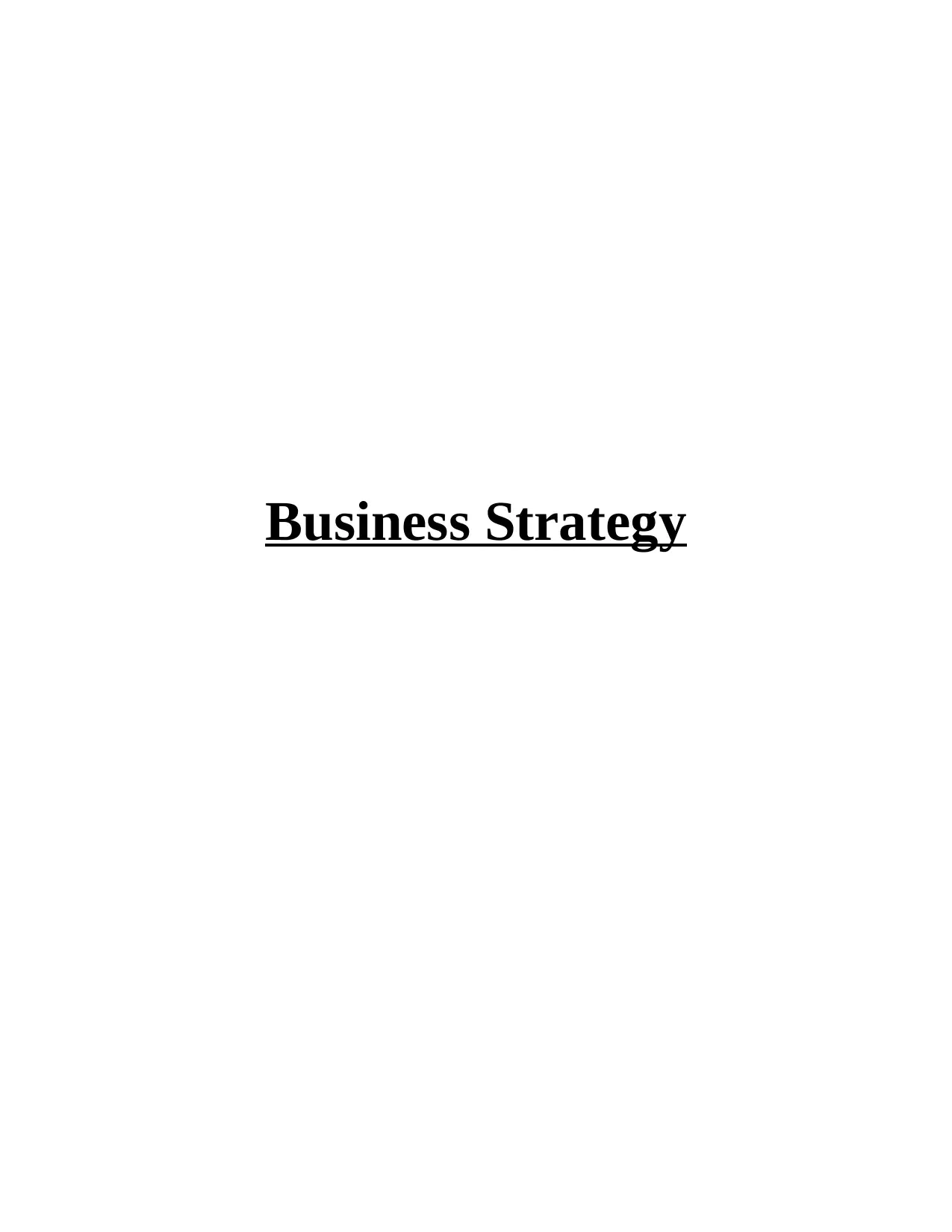
Business Strategy
Secure Best Marks with AI Grader
Need help grading? Try our AI Grader for instant feedback on your assignments.
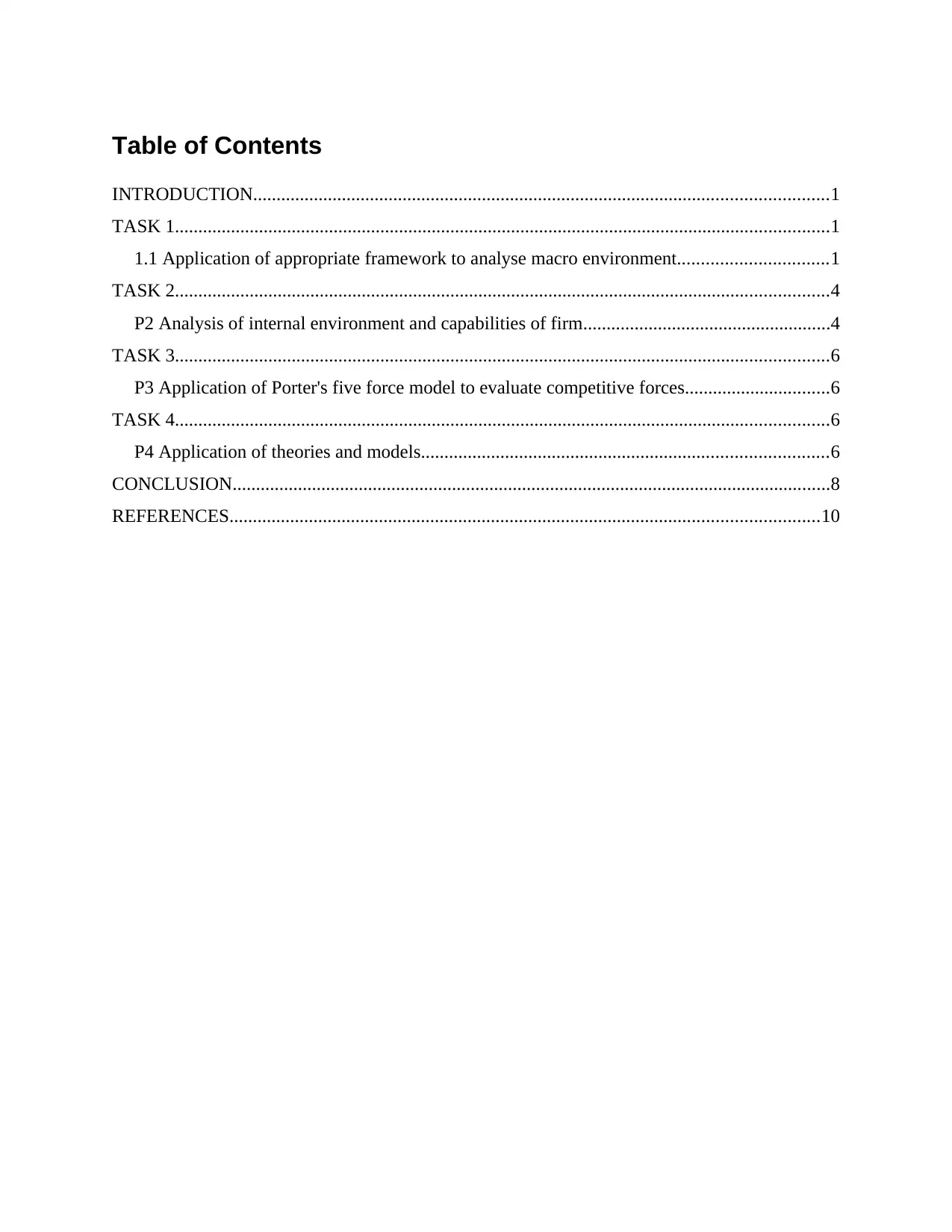
Table of Contents
INTRODUCTION...........................................................................................................................1
TASK 1............................................................................................................................................1
1.1 Application of appropriate framework to analyse macro environment................................1
TASK 2............................................................................................................................................4
P2 Analysis of internal environment and capabilities of firm.....................................................4
TASK 3............................................................................................................................................6
P3 Application of Porter's five force model to evaluate competitive forces...............................6
TASK 4............................................................................................................................................6
P4 Application of theories and models.......................................................................................6
CONCLUSION................................................................................................................................8
REFERENCES..............................................................................................................................10
INTRODUCTION...........................................................................................................................1
TASK 1............................................................................................................................................1
1.1 Application of appropriate framework to analyse macro environment................................1
TASK 2............................................................................................................................................4
P2 Analysis of internal environment and capabilities of firm.....................................................4
TASK 3............................................................................................................................................6
P3 Application of Porter's five force model to evaluate competitive forces...............................6
TASK 4............................................................................................................................................6
P4 Application of theories and models.......................................................................................6
CONCLUSION................................................................................................................................8
REFERENCES..............................................................................................................................10
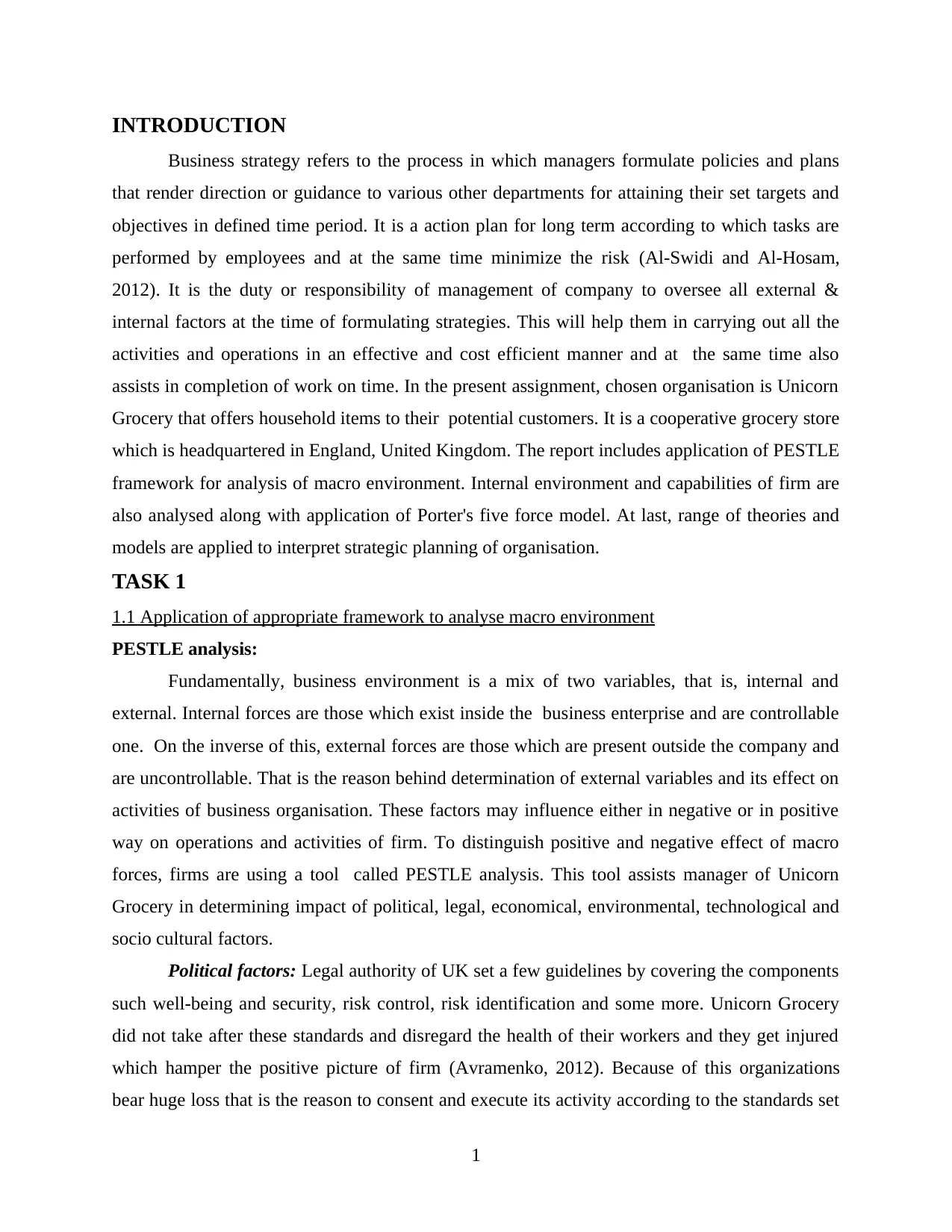
INTRODUCTION
Business strategy refers to the process in which managers formulate policies and plans
that render direction or guidance to various other departments for attaining their set targets and
objectives in defined time period. It is a action plan for long term according to which tasks are
performed by employees and at the same time minimize the risk (Al-Swidi and Al-Hosam,
2012). It is the duty or responsibility of management of company to oversee all external &
internal factors at the time of formulating strategies. This will help them in carrying out all the
activities and operations in an effective and cost efficient manner and at the same time also
assists in completion of work on time. In the present assignment, chosen organisation is Unicorn
Grocery that offers household items to their potential customers. It is a cooperative grocery store
which is headquartered in England, United Kingdom. The report includes application of PESTLE
framework for analysis of macro environment. Internal environment and capabilities of firm are
also analysed along with application of Porter's five force model. At last, range of theories and
models are applied to interpret strategic planning of organisation.
TASK 1
1.1 Application of appropriate framework to analyse macro environment
PESTLE analysis:
Fundamentally, business environment is a mix of two variables, that is, internal and
external. Internal forces are those which exist inside the business enterprise and are controllable
one. On the inverse of this, external forces are those which are present outside the company and
are uncontrollable. That is the reason behind determination of external variables and its effect on
activities of business organisation. These factors may influence either in negative or in positive
way on operations and activities of firm. To distinguish positive and negative effect of macro
forces, firms are using a tool called PESTLE analysis. This tool assists manager of Unicorn
Grocery in determining impact of political, legal, economical, environmental, technological and
socio cultural factors.
Political factors: Legal authority of UK set a few guidelines by covering the components
such well-being and security, risk control, risk identification and some more. Unicorn Grocery
did not take after these standards and disregard the health of their workers and they get injured
which hamper the positive picture of firm (Avramenko, 2012). Because of this organizations
bear huge loss that is the reason to consent and execute its activity according to the standards set
1
Business strategy refers to the process in which managers formulate policies and plans
that render direction or guidance to various other departments for attaining their set targets and
objectives in defined time period. It is a action plan for long term according to which tasks are
performed by employees and at the same time minimize the risk (Al-Swidi and Al-Hosam,
2012). It is the duty or responsibility of management of company to oversee all external &
internal factors at the time of formulating strategies. This will help them in carrying out all the
activities and operations in an effective and cost efficient manner and at the same time also
assists in completion of work on time. In the present assignment, chosen organisation is Unicorn
Grocery that offers household items to their potential customers. It is a cooperative grocery store
which is headquartered in England, United Kingdom. The report includes application of PESTLE
framework for analysis of macro environment. Internal environment and capabilities of firm are
also analysed along with application of Porter's five force model. At last, range of theories and
models are applied to interpret strategic planning of organisation.
TASK 1
1.1 Application of appropriate framework to analyse macro environment
PESTLE analysis:
Fundamentally, business environment is a mix of two variables, that is, internal and
external. Internal forces are those which exist inside the business enterprise and are controllable
one. On the inverse of this, external forces are those which are present outside the company and
are uncontrollable. That is the reason behind determination of external variables and its effect on
activities of business organisation. These factors may influence either in negative or in positive
way on operations and activities of firm. To distinguish positive and negative effect of macro
forces, firms are using a tool called PESTLE analysis. This tool assists manager of Unicorn
Grocery in determining impact of political, legal, economical, environmental, technological and
socio cultural factors.
Political factors: Legal authority of UK set a few guidelines by covering the components
such well-being and security, risk control, risk identification and some more. Unicorn Grocery
did not take after these standards and disregard the health of their workers and they get injured
which hamper the positive picture of firm (Avramenko, 2012). Because of this organizations
bear huge loss that is the reason to consent and execute its activity according to the standards set
1
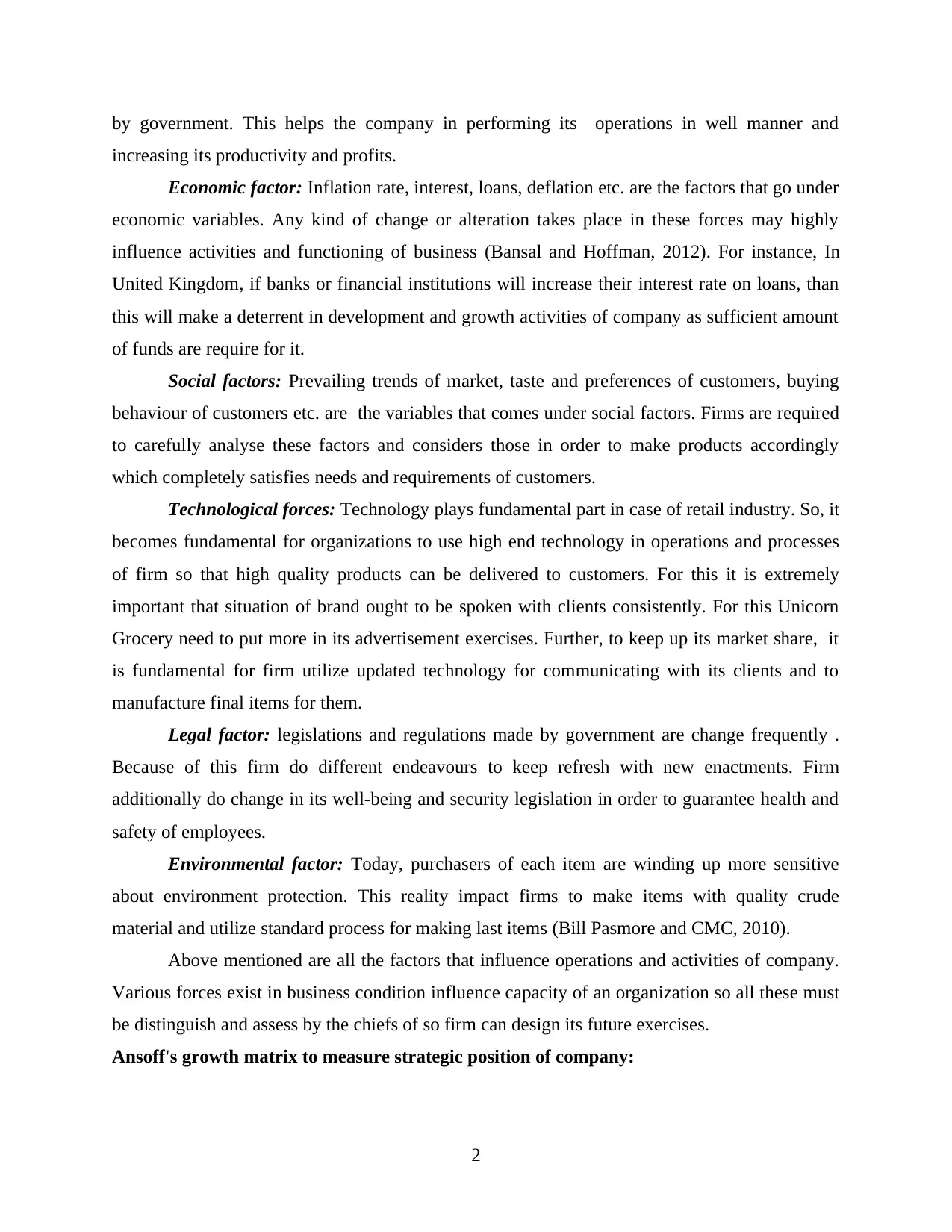
by government. This helps the company in performing its operations in well manner and
increasing its productivity and profits.
Economic factor: Inflation rate, interest, loans, deflation etc. are the factors that go under
economic variables. Any kind of change or alteration takes place in these forces may highly
influence activities and functioning of business (Bansal and Hoffman, 2012). For instance, In
United Kingdom, if banks or financial institutions will increase their interest rate on loans, than
this will make a deterrent in development and growth activities of company as sufficient amount
of funds are require for it.
Social factors: Prevailing trends of market, taste and preferences of customers, buying
behaviour of customers etc. are the variables that comes under social factors. Firms are required
to carefully analyse these factors and considers those in order to make products accordingly
which completely satisfies needs and requirements of customers.
Technological forces: Technology plays fundamental part in case of retail industry. So, it
becomes fundamental for organizations to use high end technology in operations and processes
of firm so that high quality products can be delivered to customers. For this it is extremely
important that situation of brand ought to be spoken with clients consistently. For this Unicorn
Grocery need to put more in its advertisement exercises. Further, to keep up its market share, it
is fundamental for firm utilize updated technology for communicating with its clients and to
manufacture final items for them.
Legal factor: legislations and regulations made by government are change frequently .
Because of this firm do different endeavours to keep refresh with new enactments. Firm
additionally do change in its well-being and security legislation in order to guarantee health and
safety of employees.
Environmental factor: Today, purchasers of each item are winding up more sensitive
about environment protection. This reality impact firms to make items with quality crude
material and utilize standard process for making last items (Bill Pasmore and CMC, 2010).
Above mentioned are all the factors that influence operations and activities of company.
Various forces exist in business condition influence capacity of an organization so all these must
be distinguish and assess by the chiefs of so firm can design its future exercises.
Ansoff's growth matrix to measure strategic position of company:
2
increasing its productivity and profits.
Economic factor: Inflation rate, interest, loans, deflation etc. are the factors that go under
economic variables. Any kind of change or alteration takes place in these forces may highly
influence activities and functioning of business (Bansal and Hoffman, 2012). For instance, In
United Kingdom, if banks or financial institutions will increase their interest rate on loans, than
this will make a deterrent in development and growth activities of company as sufficient amount
of funds are require for it.
Social factors: Prevailing trends of market, taste and preferences of customers, buying
behaviour of customers etc. are the variables that comes under social factors. Firms are required
to carefully analyse these factors and considers those in order to make products accordingly
which completely satisfies needs and requirements of customers.
Technological forces: Technology plays fundamental part in case of retail industry. So, it
becomes fundamental for organizations to use high end technology in operations and processes
of firm so that high quality products can be delivered to customers. For this it is extremely
important that situation of brand ought to be spoken with clients consistently. For this Unicorn
Grocery need to put more in its advertisement exercises. Further, to keep up its market share, it
is fundamental for firm utilize updated technology for communicating with its clients and to
manufacture final items for them.
Legal factor: legislations and regulations made by government are change frequently .
Because of this firm do different endeavours to keep refresh with new enactments. Firm
additionally do change in its well-being and security legislation in order to guarantee health and
safety of employees.
Environmental factor: Today, purchasers of each item are winding up more sensitive
about environment protection. This reality impact firms to make items with quality crude
material and utilize standard process for making last items (Bill Pasmore and CMC, 2010).
Above mentioned are all the factors that influence operations and activities of company.
Various forces exist in business condition influence capacity of an organization so all these must
be distinguish and assess by the chiefs of so firm can design its future exercises.
Ansoff's growth matrix to measure strategic position of company:
2
Secure Best Marks with AI Grader
Need help grading? Try our AI Grader for instant feedback on your assignments.
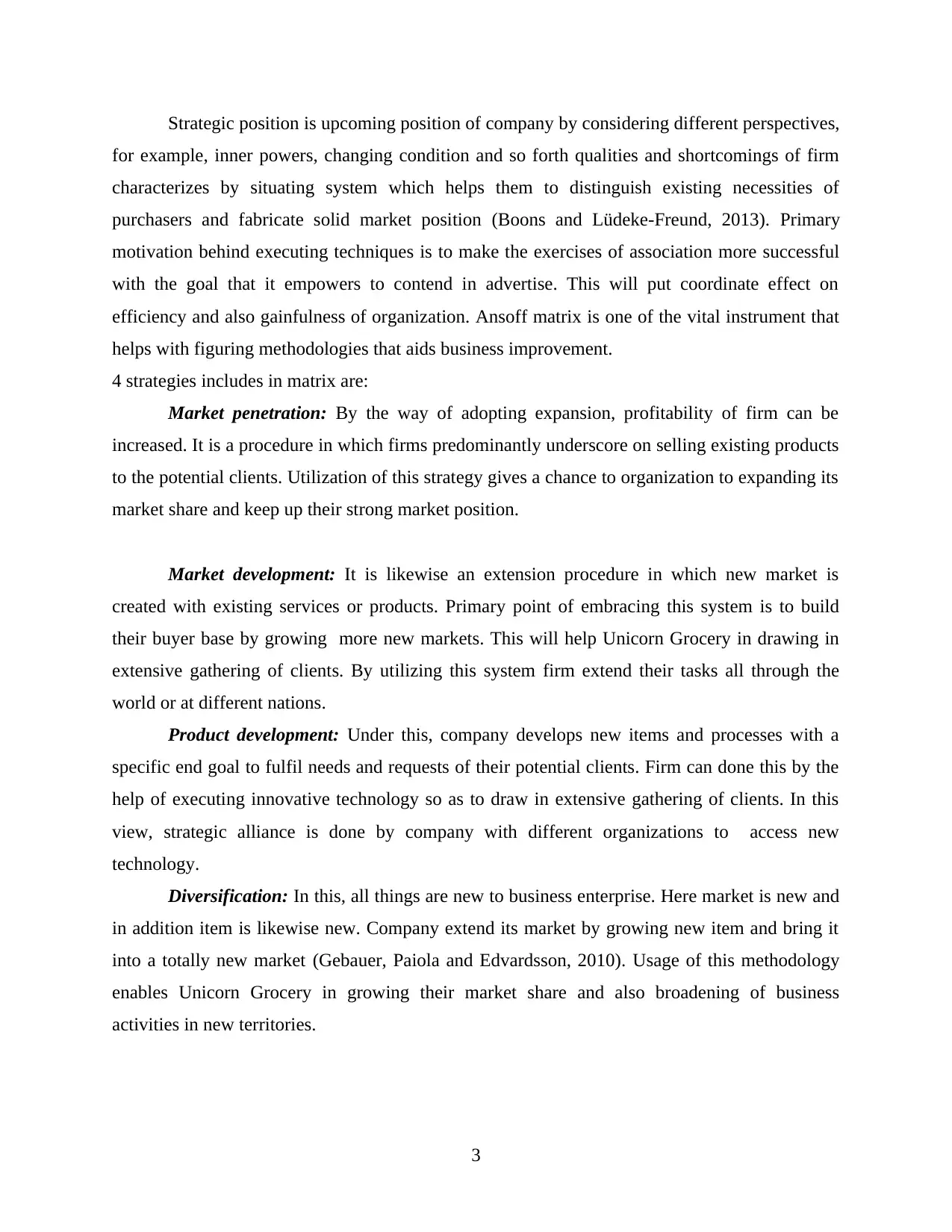
Strategic position is upcoming position of company by considering different perspectives,
for example, inner powers, changing condition and so forth qualities and shortcomings of firm
characterizes by situating system which helps them to distinguish existing necessities of
purchasers and fabricate solid market position (Boons and Lüdeke-Freund, 2013). Primary
motivation behind executing techniques is to make the exercises of association more successful
with the goal that it empowers to contend in advertise. This will put coordinate effect on
efficiency and also gainfulness of organization. Ansoff matrix is one of the vital instrument that
helps with figuring methodologies that aids business improvement.
4 strategies includes in matrix are:
Market penetration: By the way of adopting expansion, profitability of firm can be
increased. It is a procedure in which firms predominantly underscore on selling existing products
to the potential clients. Utilization of this strategy gives a chance to organization to expanding its
market share and keep up their strong market position.
Market development: It is likewise an extension procedure in which new market is
created with existing services or products. Primary point of embracing this system is to build
their buyer base by growing more new markets. This will help Unicorn Grocery in drawing in
extensive gathering of clients. By utilizing this system firm extend their tasks all through the
world or at different nations.
Product development: Under this, company develops new items and processes with a
specific end goal to fulfil needs and requests of their potential clients. Firm can done this by the
help of executing innovative technology so as to draw in extensive gathering of clients. In this
view, strategic alliance is done by company with different organizations to access new
technology.
Diversification: In this, all things are new to business enterprise. Here market is new and
in addition item is likewise new. Company extend its market by growing new item and bring it
into a totally new market (Gebauer, Paiola and Edvardsson, 2010). Usage of this methodology
enables Unicorn Grocery in growing their market share and also broadening of business
activities in new territories.
3
for example, inner powers, changing condition and so forth qualities and shortcomings of firm
characterizes by situating system which helps them to distinguish existing necessities of
purchasers and fabricate solid market position (Boons and Lüdeke-Freund, 2013). Primary
motivation behind executing techniques is to make the exercises of association more successful
with the goal that it empowers to contend in advertise. This will put coordinate effect on
efficiency and also gainfulness of organization. Ansoff matrix is one of the vital instrument that
helps with figuring methodologies that aids business improvement.
4 strategies includes in matrix are:
Market penetration: By the way of adopting expansion, profitability of firm can be
increased. It is a procedure in which firms predominantly underscore on selling existing products
to the potential clients. Utilization of this strategy gives a chance to organization to expanding its
market share and keep up their strong market position.
Market development: It is likewise an extension procedure in which new market is
created with existing services or products. Primary point of embracing this system is to build
their buyer base by growing more new markets. This will help Unicorn Grocery in drawing in
extensive gathering of clients. By utilizing this system firm extend their tasks all through the
world or at different nations.
Product development: Under this, company develops new items and processes with a
specific end goal to fulfil needs and requests of their potential clients. Firm can done this by the
help of executing innovative technology so as to draw in extensive gathering of clients. In this
view, strategic alliance is done by company with different organizations to access new
technology.
Diversification: In this, all things are new to business enterprise. Here market is new and
in addition item is likewise new. Company extend its market by growing new item and bring it
into a totally new market (Gebauer, Paiola and Edvardsson, 2010). Usage of this methodology
enables Unicorn Grocery in growing their market share and also broadening of business
activities in new territories.
3
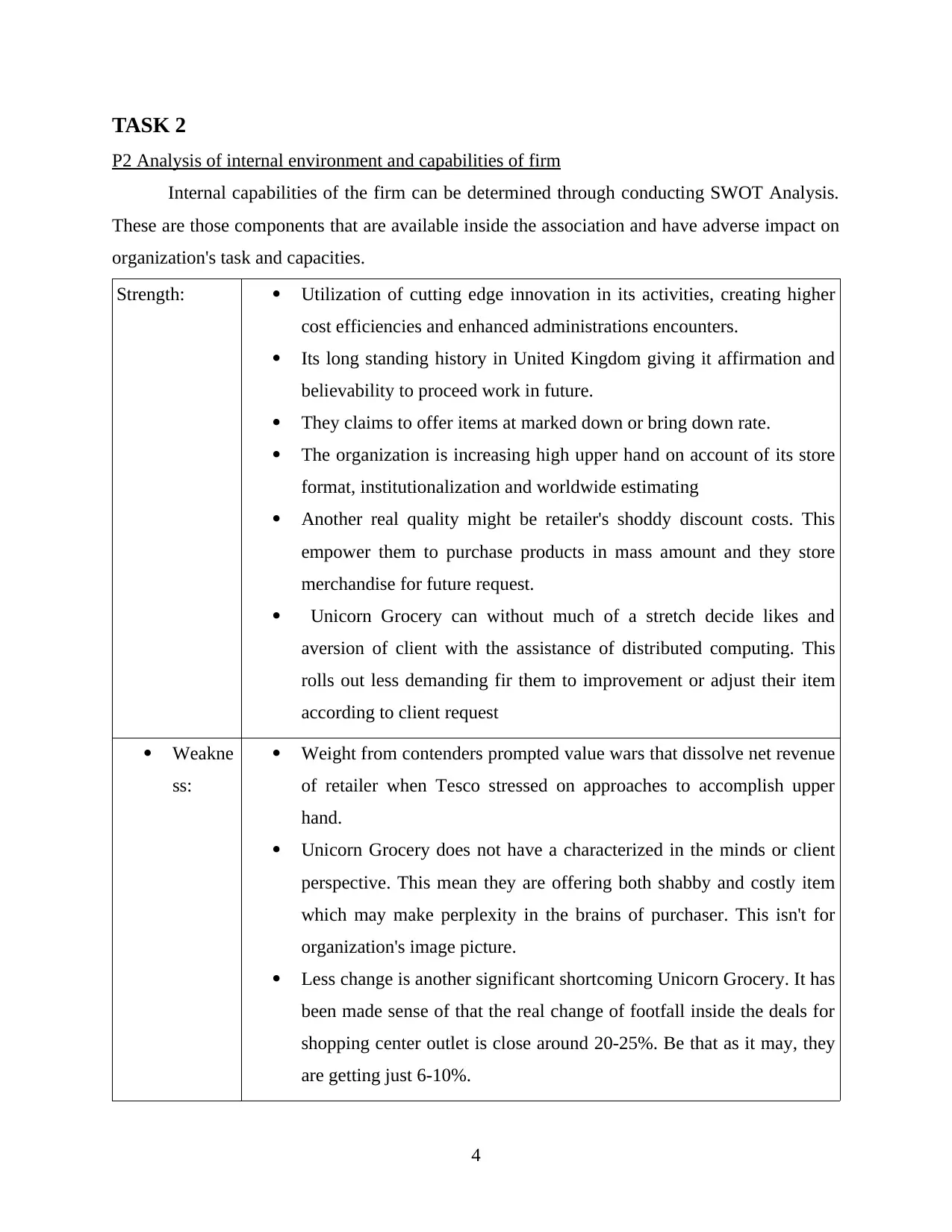
TASK 2
P2 Analysis of internal environment and capabilities of firm
Internal capabilities of the firm can be determined through conducting SWOT Analysis.
These are those components that are available inside the association and have adverse impact on
organization's task and capacities.
Strength: Utilization of cutting edge innovation in its activities, creating higher
cost efficiencies and enhanced administrations encounters.
Its long standing history in United Kingdom giving it affirmation and
believability to proceed work in future.
They claims to offer items at marked down or bring down rate.
The organization is increasing high upper hand on account of its store
format, institutionalization and worldwide estimating
Another real quality might be retailer's shoddy discount costs. This
empower them to purchase products in mass amount and they store
merchandise for future request.
Unicorn Grocery can without much of a stretch decide likes and
aversion of client with the assistance of distributed computing. This
rolls out less demanding fir them to improvement or adjust their item
according to client request
Weakne
ss:
Weight from contenders prompted value wars that dissolve net revenue
of retailer when Tesco stressed on approaches to accomplish upper
hand.
Unicorn Grocery does not have a characterized in the minds or client
perspective. This mean they are offering both shabby and costly item
which may make perplexity in the brains of purchaser. This isn't for
organization's image picture.
Less change is another significant shortcoming Unicorn Grocery. It has
been made sense of that the real change of footfall inside the deals for
shopping center outlet is close around 20-25%. Be that as it may, they
are getting just 6-10%.
4
P2 Analysis of internal environment and capabilities of firm
Internal capabilities of the firm can be determined through conducting SWOT Analysis.
These are those components that are available inside the association and have adverse impact on
organization's task and capacities.
Strength: Utilization of cutting edge innovation in its activities, creating higher
cost efficiencies and enhanced administrations encounters.
Its long standing history in United Kingdom giving it affirmation and
believability to proceed work in future.
They claims to offer items at marked down or bring down rate.
The organization is increasing high upper hand on account of its store
format, institutionalization and worldwide estimating
Another real quality might be retailer's shoddy discount costs. This
empower them to purchase products in mass amount and they store
merchandise for future request.
Unicorn Grocery can without much of a stretch decide likes and
aversion of client with the assistance of distributed computing. This
rolls out less demanding fir them to improvement or adjust their item
according to client request
Weakne
ss:
Weight from contenders prompted value wars that dissolve net revenue
of retailer when Tesco stressed on approaches to accomplish upper
hand.
Unicorn Grocery does not have a characterized in the minds or client
perspective. This mean they are offering both shabby and costly item
which may make perplexity in the brains of purchaser. This isn't for
organization's image picture.
Less change is another significant shortcoming Unicorn Grocery. It has
been made sense of that the real change of footfall inside the deals for
shopping center outlet is close around 20-25%. Be that as it may, they
are getting just 6-10%.
4
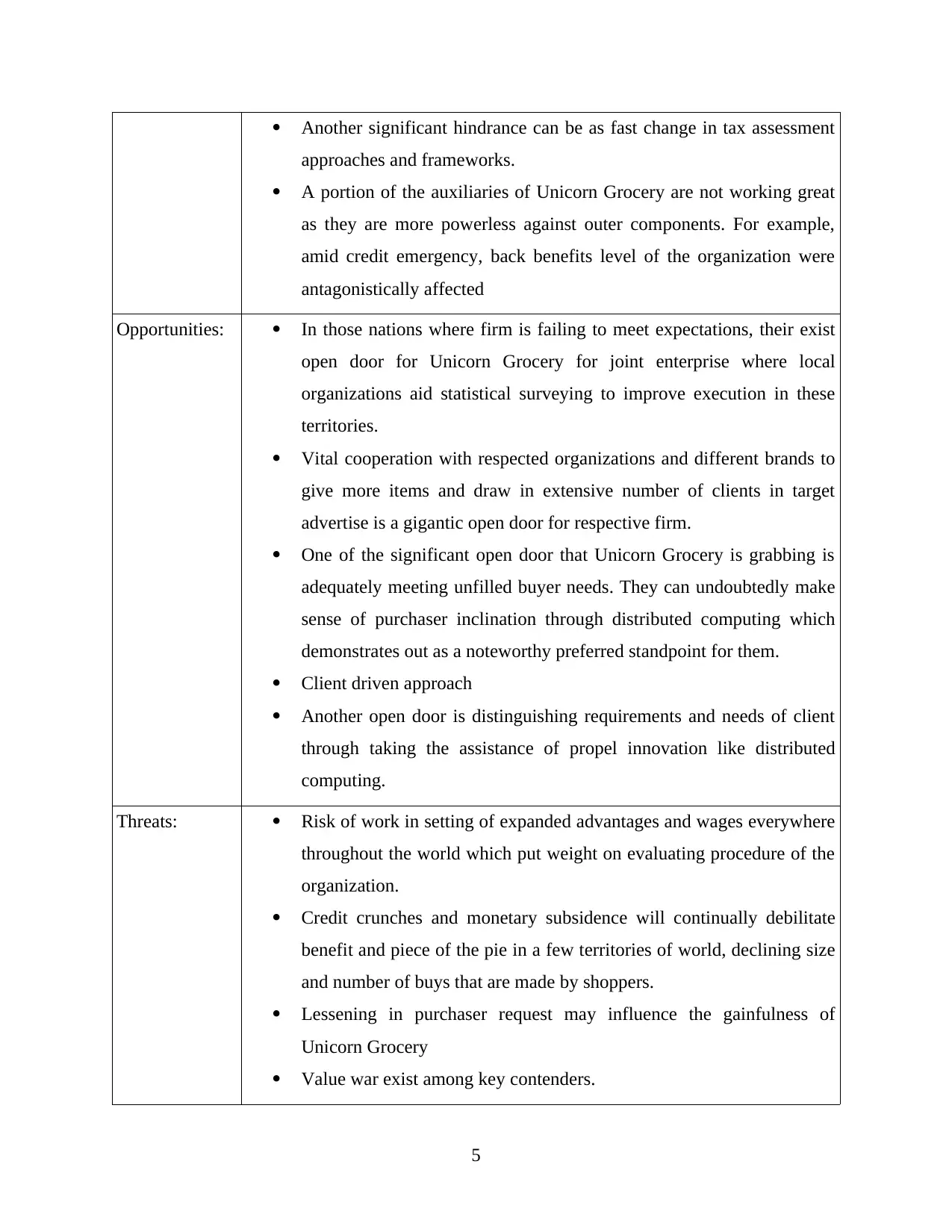
Another significant hindrance can be as fast change in tax assessment
approaches and frameworks.
A portion of the auxiliaries of Unicorn Grocery are not working great
as they are more powerless against outer components. For example,
amid credit emergency, back benefits level of the organization were
antagonistically affected
Opportunities: In those nations where firm is failing to meet expectations, their exist
open door for Unicorn Grocery for joint enterprise where local
organizations aid statistical surveying to improve execution in these
territories.
Vital cooperation with respected organizations and different brands to
give more items and draw in extensive number of clients in target
advertise is a gigantic open door for respective firm.
One of the significant open door that Unicorn Grocery is grabbing is
adequately meeting unfilled buyer needs. They can undoubtedly make
sense of purchaser inclination through distributed computing which
demonstrates out as a noteworthy preferred standpoint for them.
Client driven approach
Another open door is distinguishing requirements and needs of client
through taking the assistance of propel innovation like distributed
computing.
Threats: Risk of work in setting of expanded advantages and wages everywhere
throughout the world which put weight on evaluating procedure of the
organization.
Credit crunches and monetary subsidence will continually debilitate
benefit and piece of the pie in a few territories of world, declining size
and number of buys that are made by shoppers.
Lessening in purchaser request may influence the gainfulness of
Unicorn Grocery
Value war exist among key contenders.
5
approaches and frameworks.
A portion of the auxiliaries of Unicorn Grocery are not working great
as they are more powerless against outer components. For example,
amid credit emergency, back benefits level of the organization were
antagonistically affected
Opportunities: In those nations where firm is failing to meet expectations, their exist
open door for Unicorn Grocery for joint enterprise where local
organizations aid statistical surveying to improve execution in these
territories.
Vital cooperation with respected organizations and different brands to
give more items and draw in extensive number of clients in target
advertise is a gigantic open door for respective firm.
One of the significant open door that Unicorn Grocery is grabbing is
adequately meeting unfilled buyer needs. They can undoubtedly make
sense of purchaser inclination through distributed computing which
demonstrates out as a noteworthy preferred standpoint for them.
Client driven approach
Another open door is distinguishing requirements and needs of client
through taking the assistance of propel innovation like distributed
computing.
Threats: Risk of work in setting of expanded advantages and wages everywhere
throughout the world which put weight on evaluating procedure of the
organization.
Credit crunches and monetary subsidence will continually debilitate
benefit and piece of the pie in a few territories of world, declining size
and number of buys that are made by shoppers.
Lessening in purchaser request may influence the gainfulness of
Unicorn Grocery
Value war exist among key contenders.
5
Paraphrase This Document
Need a fresh take? Get an instant paraphrase of this document with our AI Paraphraser
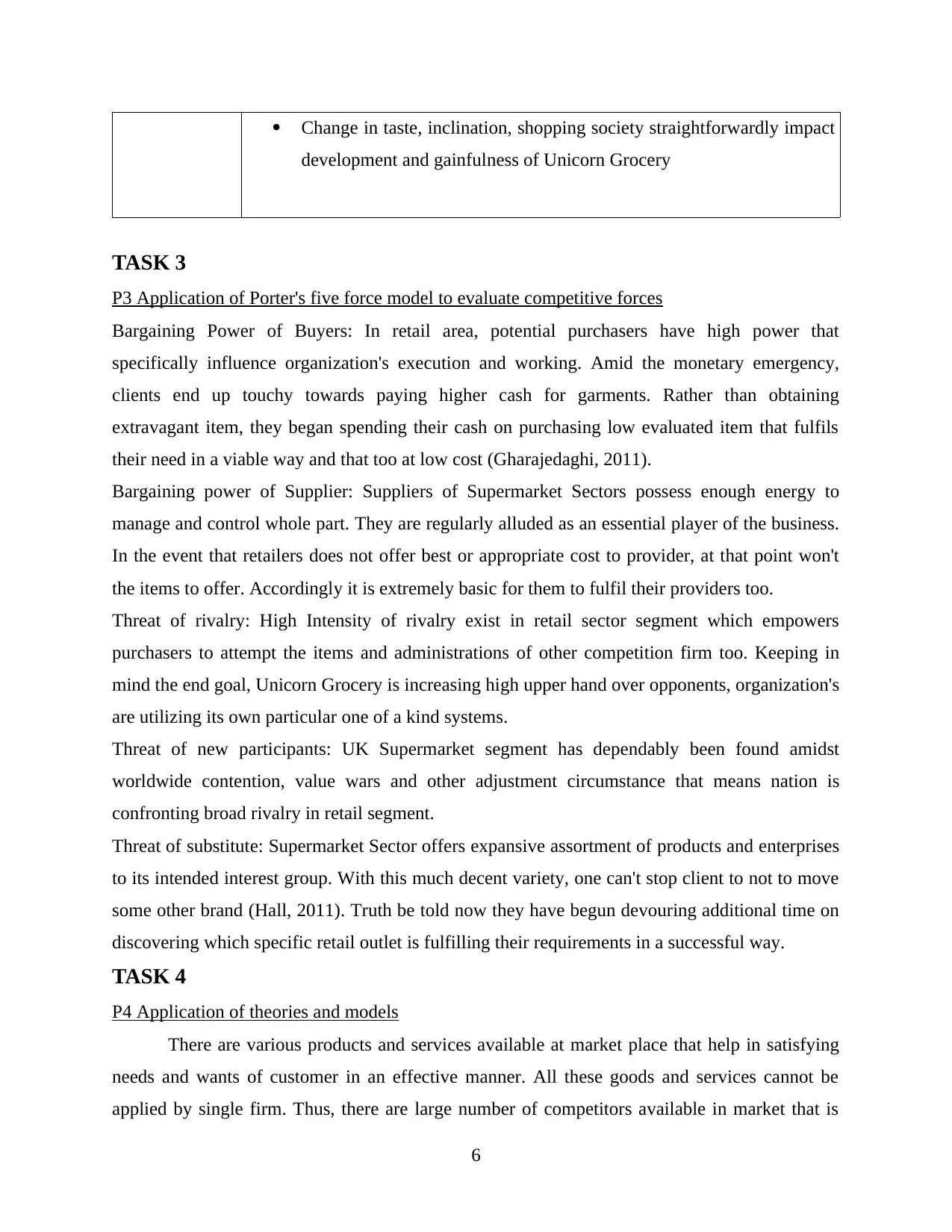
Change in taste, inclination, shopping society straightforwardly impact
development and gainfulness of Unicorn Grocery
TASK 3
P3 Application of Porter's five force model to evaluate competitive forces
Bargaining Power of Buyers: In retail area, potential purchasers have high power that
specifically influence organization's execution and working. Amid the monetary emergency,
clients end up touchy towards paying higher cash for garments. Rather than obtaining
extravagant item, they began spending their cash on purchasing low evaluated item that fulfils
their need in a viable way and that too at low cost (Gharajedaghi, 2011).
Bargaining power of Supplier: Suppliers of Supermarket Sectors possess enough energy to
manage and control whole part. They are regularly alluded as an essential player of the business.
In the event that retailers does not offer best or appropriate cost to provider, at that point won't
the items to offer. Accordingly it is extremely basic for them to fulfil their providers too.
Threat of rivalry: High Intensity of rivalry exist in retail sector segment which empowers
purchasers to attempt the items and administrations of other competition firm too. Keeping in
mind the end goal, Unicorn Grocery is increasing high upper hand over opponents, organization's
are utilizing its own particular one of a kind systems.
Threat of new participants: UK Supermarket segment has dependably been found amidst
worldwide contention, value wars and other adjustment circumstance that means nation is
confronting broad rivalry in retail segment.
Threat of substitute: Supermarket Sector offers expansive assortment of products and enterprises
to its intended interest group. With this much decent variety, one can't stop client to not to move
some other brand (Hall, 2011). Truth be told now they have begun devouring additional time on
discovering which specific retail outlet is fulfilling their requirements in a successful way.
TASK 4
P4 Application of theories and models
There are various products and services available at market place that help in satisfying
needs and wants of customer in an effective manner. All these goods and services cannot be
applied by single firm. Thus, there are large number of competitors available in market that is
6
development and gainfulness of Unicorn Grocery
TASK 3
P3 Application of Porter's five force model to evaluate competitive forces
Bargaining Power of Buyers: In retail area, potential purchasers have high power that
specifically influence organization's execution and working. Amid the monetary emergency,
clients end up touchy towards paying higher cash for garments. Rather than obtaining
extravagant item, they began spending their cash on purchasing low evaluated item that fulfils
their need in a viable way and that too at low cost (Gharajedaghi, 2011).
Bargaining power of Supplier: Suppliers of Supermarket Sectors possess enough energy to
manage and control whole part. They are regularly alluded as an essential player of the business.
In the event that retailers does not offer best or appropriate cost to provider, at that point won't
the items to offer. Accordingly it is extremely basic for them to fulfil their providers too.
Threat of rivalry: High Intensity of rivalry exist in retail sector segment which empowers
purchasers to attempt the items and administrations of other competition firm too. Keeping in
mind the end goal, Unicorn Grocery is increasing high upper hand over opponents, organization's
are utilizing its own particular one of a kind systems.
Threat of new participants: UK Supermarket segment has dependably been found amidst
worldwide contention, value wars and other adjustment circumstance that means nation is
confronting broad rivalry in retail segment.
Threat of substitute: Supermarket Sector offers expansive assortment of products and enterprises
to its intended interest group. With this much decent variety, one can't stop client to not to move
some other brand (Hall, 2011). Truth be told now they have begun devouring additional time on
discovering which specific retail outlet is fulfilling their requirements in a successful way.
TASK 4
P4 Application of theories and models
There are various products and services available at market place that help in satisfying
needs and wants of customer in an effective manner. All these goods and services cannot be
applied by single firm. Thus, there are large number of competitors available in market that is
6
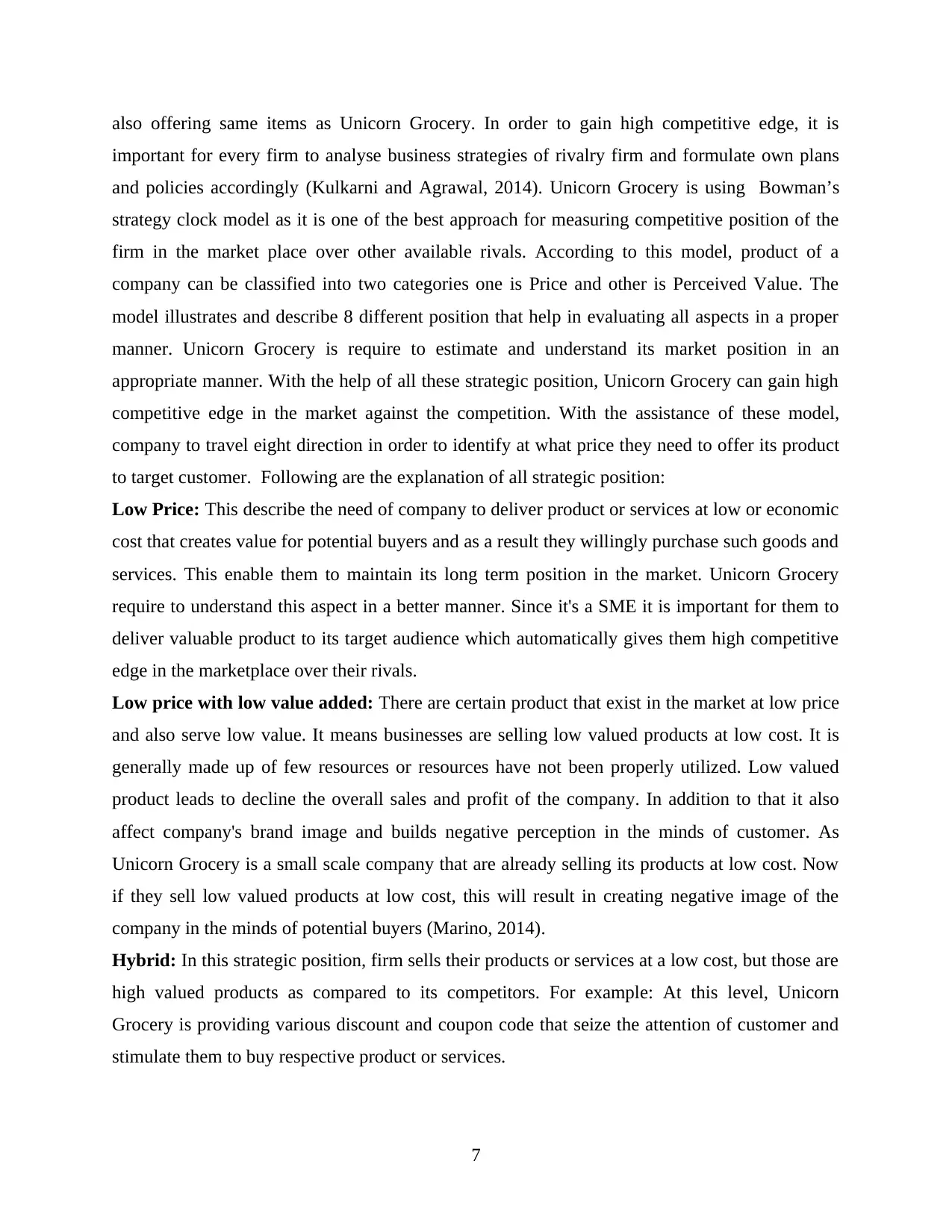
also offering same items as Unicorn Grocery. In order to gain high competitive edge, it is
important for every firm to analyse business strategies of rivalry firm and formulate own plans
and policies accordingly (Kulkarni and Agrawal, 2014). Unicorn Grocery is using Bowman’s
strategy clock model as it is one of the best approach for measuring competitive position of the
firm in the market place over other available rivals. According to this model, product of a
company can be classified into two categories one is Price and other is Perceived Value. The
model illustrates and describe 8 different position that help in evaluating all aspects in a proper
manner. Unicorn Grocery is require to estimate and understand its market position in an
appropriate manner. With the help of all these strategic position, Unicorn Grocery can gain high
competitive edge in the market against the competition. With the assistance of these model,
company to travel eight direction in order to identify at what price they need to offer its product
to target customer. Following are the explanation of all strategic position:
Low Price: This describe the need of company to deliver product or services at low or economic
cost that creates value for potential buyers and as a result they willingly purchase such goods and
services. This enable them to maintain its long term position in the market. Unicorn Grocery
require to understand this aspect in a better manner. Since it's a SME it is important for them to
deliver valuable product to its target audience which automatically gives them high competitive
edge in the marketplace over their rivals.
Low price with low value added: There are certain product that exist in the market at low price
and also serve low value. It means businesses are selling low valued products at low cost. It is
generally made up of few resources or resources have not been properly utilized. Low valued
product leads to decline the overall sales and profit of the company. In addition to that it also
affect company's brand image and builds negative perception in the minds of customer. As
Unicorn Grocery is a small scale company that are already selling its products at low cost. Now
if they sell low valued products at low cost, this will result in creating negative image of the
company in the minds of potential buyers (Marino, 2014).
Hybrid: In this strategic position, firm sells their products or services at a low cost, but those are
high valued products as compared to its competitors. For example: At this level, Unicorn
Grocery is providing various discount and coupon code that seize the attention of customer and
stimulate them to buy respective product or services.
7
important for every firm to analyse business strategies of rivalry firm and formulate own plans
and policies accordingly (Kulkarni and Agrawal, 2014). Unicorn Grocery is using Bowman’s
strategy clock model as it is one of the best approach for measuring competitive position of the
firm in the market place over other available rivals. According to this model, product of a
company can be classified into two categories one is Price and other is Perceived Value. The
model illustrates and describe 8 different position that help in evaluating all aspects in a proper
manner. Unicorn Grocery is require to estimate and understand its market position in an
appropriate manner. With the help of all these strategic position, Unicorn Grocery can gain high
competitive edge in the market against the competition. With the assistance of these model,
company to travel eight direction in order to identify at what price they need to offer its product
to target customer. Following are the explanation of all strategic position:
Low Price: This describe the need of company to deliver product or services at low or economic
cost that creates value for potential buyers and as a result they willingly purchase such goods and
services. This enable them to maintain its long term position in the market. Unicorn Grocery
require to understand this aspect in a better manner. Since it's a SME it is important for them to
deliver valuable product to its target audience which automatically gives them high competitive
edge in the marketplace over their rivals.
Low price with low value added: There are certain product that exist in the market at low price
and also serve low value. It means businesses are selling low valued products at low cost. It is
generally made up of few resources or resources have not been properly utilized. Low valued
product leads to decline the overall sales and profit of the company. In addition to that it also
affect company's brand image and builds negative perception in the minds of customer. As
Unicorn Grocery is a small scale company that are already selling its products at low cost. Now
if they sell low valued products at low cost, this will result in creating negative image of the
company in the minds of potential buyers (Marino, 2014).
Hybrid: In this strategic position, firm sells their products or services at a low cost, but those are
high valued products as compared to its competitors. For example: At this level, Unicorn
Grocery is providing various discount and coupon code that seize the attention of customer and
stimulate them to buy respective product or services.
7
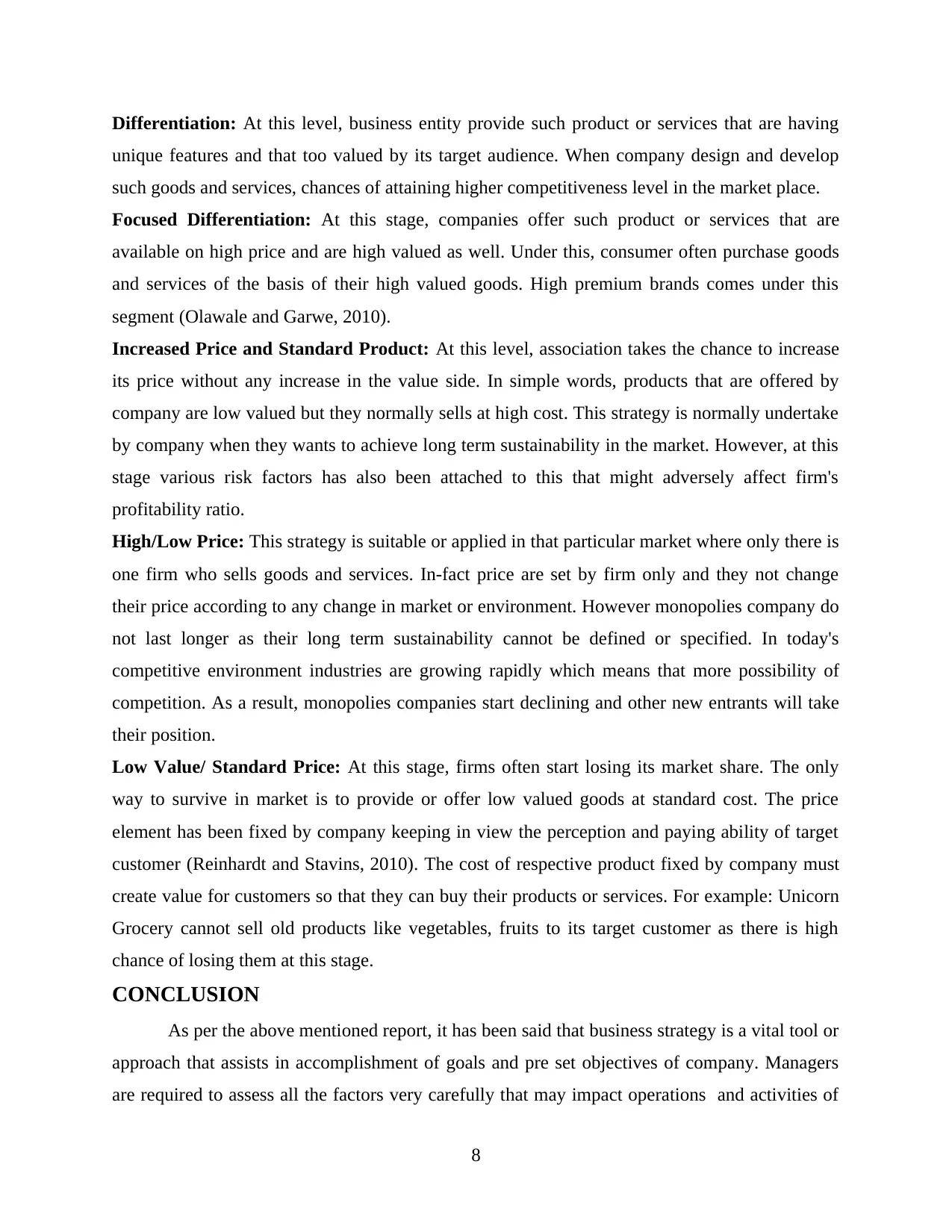
Differentiation: At this level, business entity provide such product or services that are having
unique features and that too valued by its target audience. When company design and develop
such goods and services, chances of attaining higher competitiveness level in the market place.
Focused Differentiation: At this stage, companies offer such product or services that are
available on high price and are high valued as well. Under this, consumer often purchase goods
and services of the basis of their high valued goods. High premium brands comes under this
segment (Olawale and Garwe, 2010).
Increased Price and Standard Product: At this level, association takes the chance to increase
its price without any increase in the value side. In simple words, products that are offered by
company are low valued but they normally sells at high cost. This strategy is normally undertake
by company when they wants to achieve long term sustainability in the market. However, at this
stage various risk factors has also been attached to this that might adversely affect firm's
profitability ratio.
High/Low Price: This strategy is suitable or applied in that particular market where only there is
one firm who sells goods and services. In-fact price are set by firm only and they not change
their price according to any change in market or environment. However monopolies company do
not last longer as their long term sustainability cannot be defined or specified. In today's
competitive environment industries are growing rapidly which means that more possibility of
competition. As a result, monopolies companies start declining and other new entrants will take
their position.
Low Value/ Standard Price: At this stage, firms often start losing its market share. The only
way to survive in market is to provide or offer low valued goods at standard cost. The price
element has been fixed by company keeping in view the perception and paying ability of target
customer (Reinhardt and Stavins, 2010). The cost of respective product fixed by company must
create value for customers so that they can buy their products or services. For example: Unicorn
Grocery cannot sell old products like vegetables, fruits to its target customer as there is high
chance of losing them at this stage.
CONCLUSION
As per the above mentioned report, it has been said that business strategy is a vital tool or
approach that assists in accomplishment of goals and pre set objectives of company. Managers
are required to assess all the factors very carefully that may impact operations and activities of
8
unique features and that too valued by its target audience. When company design and develop
such goods and services, chances of attaining higher competitiveness level in the market place.
Focused Differentiation: At this stage, companies offer such product or services that are
available on high price and are high valued as well. Under this, consumer often purchase goods
and services of the basis of their high valued goods. High premium brands comes under this
segment (Olawale and Garwe, 2010).
Increased Price and Standard Product: At this level, association takes the chance to increase
its price without any increase in the value side. In simple words, products that are offered by
company are low valued but they normally sells at high cost. This strategy is normally undertake
by company when they wants to achieve long term sustainability in the market. However, at this
stage various risk factors has also been attached to this that might adversely affect firm's
profitability ratio.
High/Low Price: This strategy is suitable or applied in that particular market where only there is
one firm who sells goods and services. In-fact price are set by firm only and they not change
their price according to any change in market or environment. However monopolies company do
not last longer as their long term sustainability cannot be defined or specified. In today's
competitive environment industries are growing rapidly which means that more possibility of
competition. As a result, monopolies companies start declining and other new entrants will take
their position.
Low Value/ Standard Price: At this stage, firms often start losing its market share. The only
way to survive in market is to provide or offer low valued goods at standard cost. The price
element has been fixed by company keeping in view the perception and paying ability of target
customer (Reinhardt and Stavins, 2010). The cost of respective product fixed by company must
create value for customers so that they can buy their products or services. For example: Unicorn
Grocery cannot sell old products like vegetables, fruits to its target customer as there is high
chance of losing them at this stage.
CONCLUSION
As per the above mentioned report, it has been said that business strategy is a vital tool or
approach that assists in accomplishment of goals and pre set objectives of company. Managers
are required to assess all the factors very carefully that may impact operations and activities of
8
Secure Best Marks with AI Grader
Need help grading? Try our AI Grader for instant feedback on your assignments.
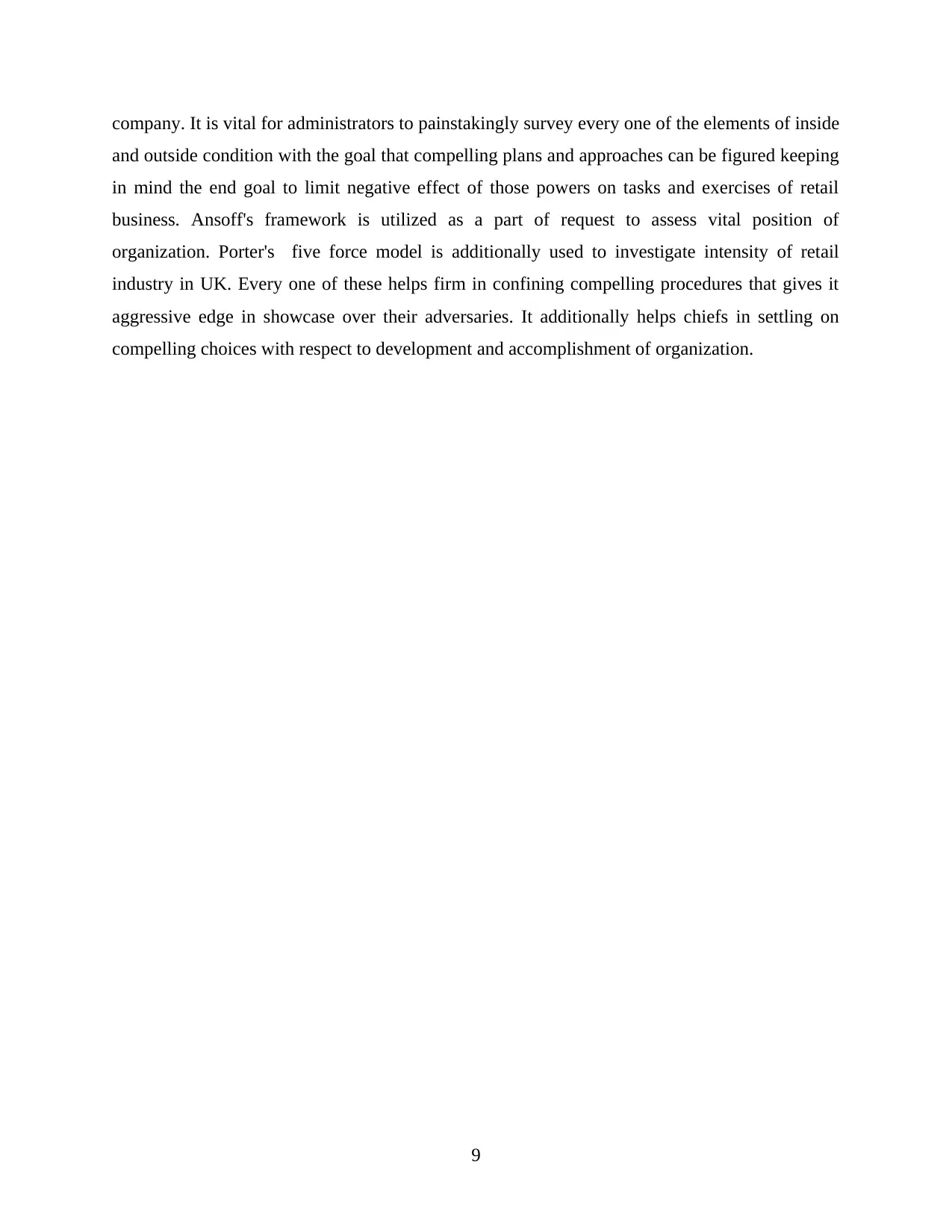
company. It is vital for administrators to painstakingly survey every one of the elements of inside
and outside condition with the goal that compelling plans and approaches can be figured keeping
in mind the end goal to limit negative effect of those powers on tasks and exercises of retail
business. Ansoff's framework is utilized as a part of request to assess vital position of
organization. Porter's five force model is additionally used to investigate intensity of retail
industry in UK. Every one of these helps firm in confining compelling procedures that gives it
aggressive edge in showcase over their adversaries. It additionally helps chiefs in settling on
compelling choices with respect to development and accomplishment of organization.
9
and outside condition with the goal that compelling plans and approaches can be figured keeping
in mind the end goal to limit negative effect of those powers on tasks and exercises of retail
business. Ansoff's framework is utilized as a part of request to assess vital position of
organization. Porter's five force model is additionally used to investigate intensity of retail
industry in UK. Every one of these helps firm in confining compelling procedures that gives it
aggressive edge in showcase over their adversaries. It additionally helps chiefs in settling on
compelling choices with respect to development and accomplishment of organization.
9
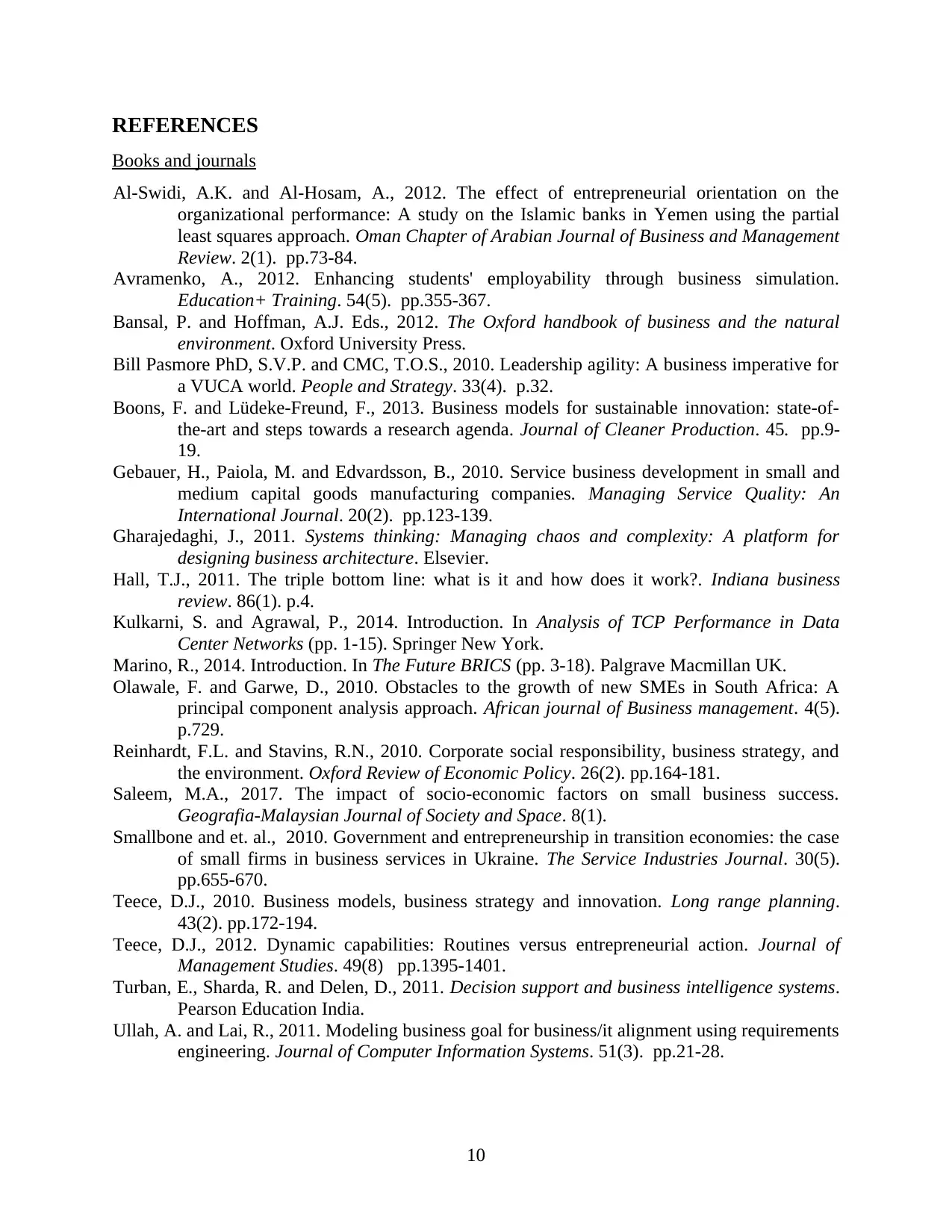
REFERENCES
Books and journals
Al-Swidi, A.K. and Al-Hosam, A., 2012. The effect of entrepreneurial orientation on the
organizational performance: A study on the Islamic banks in Yemen using the partial
least squares approach. Oman Chapter of Arabian Journal of Business and Management
Review. 2(1). pp.73-84.
Avramenko, A., 2012. Enhancing students' employability through business simulation.
Education+ Training. 54(5). pp.355-367.
Bansal, P. and Hoffman, A.J. Eds., 2012. The Oxford handbook of business and the natural
environment. Oxford University Press.
Bill Pasmore PhD, S.V.P. and CMC, T.O.S., 2010. Leadership agility: A business imperative for
a VUCA world. People and Strategy. 33(4). p.32.
Boons, F. and Lüdeke-Freund, F., 2013. Business models for sustainable innovation: state-of-
the-art and steps towards a research agenda. Journal of Cleaner Production. 45. pp.9-
19.
Gebauer, H., Paiola, M. and Edvardsson, B., 2010. Service business development in small and
medium capital goods manufacturing companies. Managing Service Quality: An
International Journal. 20(2). pp.123-139.
Gharajedaghi, J., 2011. Systems thinking: Managing chaos and complexity: A platform for
designing business architecture. Elsevier.
Hall, T.J., 2011. The triple bottom line: what is it and how does it work?. Indiana business
review. 86(1). p.4.
Kulkarni, S. and Agrawal, P., 2014. Introduction. In Analysis of TCP Performance in Data
Center Networks (pp. 1-15). Springer New York.
Marino, R., 2014. Introduction. In The Future BRICS (pp. 3-18). Palgrave Macmillan UK.
Olawale, F. and Garwe, D., 2010. Obstacles to the growth of new SMEs in South Africa: A
principal component analysis approach. African journal of Business management. 4(5).
p.729.
Reinhardt, F.L. and Stavins, R.N., 2010. Corporate social responsibility, business strategy, and
the environment. Oxford Review of Economic Policy. 26(2). pp.164-181.
Saleem, M.A., 2017. The impact of socio-economic factors on small business success.
Geografia-Malaysian Journal of Society and Space. 8(1).
Smallbone and et. al., 2010. Government and entrepreneurship in transition economies: the case
of small firms in business services in Ukraine. The Service Industries Journal. 30(5).
pp.655-670.
Teece, D.J., 2010. Business models, business strategy and innovation. Long range planning.
43(2). pp.172-194.
Teece, D.J., 2012. Dynamic capabilities: Routines versus entrepreneurial action. Journal of
Management Studies. 49(8) pp.1395-1401.
Turban, E., Sharda, R. and Delen, D., 2011. Decision support and business intelligence systems.
Pearson Education India.
Ullah, A. and Lai, R., 2011. Modeling business goal for business/it alignment using requirements
engineering. Journal of Computer Information Systems. 51(3). pp.21-28.
10
Books and journals
Al-Swidi, A.K. and Al-Hosam, A., 2012. The effect of entrepreneurial orientation on the
organizational performance: A study on the Islamic banks in Yemen using the partial
least squares approach. Oman Chapter of Arabian Journal of Business and Management
Review. 2(1). pp.73-84.
Avramenko, A., 2012. Enhancing students' employability through business simulation.
Education+ Training. 54(5). pp.355-367.
Bansal, P. and Hoffman, A.J. Eds., 2012. The Oxford handbook of business and the natural
environment. Oxford University Press.
Bill Pasmore PhD, S.V.P. and CMC, T.O.S., 2010. Leadership agility: A business imperative for
a VUCA world. People and Strategy. 33(4). p.32.
Boons, F. and Lüdeke-Freund, F., 2013. Business models for sustainable innovation: state-of-
the-art and steps towards a research agenda. Journal of Cleaner Production. 45. pp.9-
19.
Gebauer, H., Paiola, M. and Edvardsson, B., 2010. Service business development in small and
medium capital goods manufacturing companies. Managing Service Quality: An
International Journal. 20(2). pp.123-139.
Gharajedaghi, J., 2011. Systems thinking: Managing chaos and complexity: A platform for
designing business architecture. Elsevier.
Hall, T.J., 2011. The triple bottom line: what is it and how does it work?. Indiana business
review. 86(1). p.4.
Kulkarni, S. and Agrawal, P., 2014. Introduction. In Analysis of TCP Performance in Data
Center Networks (pp. 1-15). Springer New York.
Marino, R., 2014. Introduction. In The Future BRICS (pp. 3-18). Palgrave Macmillan UK.
Olawale, F. and Garwe, D., 2010. Obstacles to the growth of new SMEs in South Africa: A
principal component analysis approach. African journal of Business management. 4(5).
p.729.
Reinhardt, F.L. and Stavins, R.N., 2010. Corporate social responsibility, business strategy, and
the environment. Oxford Review of Economic Policy. 26(2). pp.164-181.
Saleem, M.A., 2017. The impact of socio-economic factors on small business success.
Geografia-Malaysian Journal of Society and Space. 8(1).
Smallbone and et. al., 2010. Government and entrepreneurship in transition economies: the case
of small firms in business services in Ukraine. The Service Industries Journal. 30(5).
pp.655-670.
Teece, D.J., 2010. Business models, business strategy and innovation. Long range planning.
43(2). pp.172-194.
Teece, D.J., 2012. Dynamic capabilities: Routines versus entrepreneurial action. Journal of
Management Studies. 49(8) pp.1395-1401.
Turban, E., Sharda, R. and Delen, D., 2011. Decision support and business intelligence systems.
Pearson Education India.
Ullah, A. and Lai, R., 2011. Modeling business goal for business/it alignment using requirements
engineering. Journal of Computer Information Systems. 51(3). pp.21-28.
10
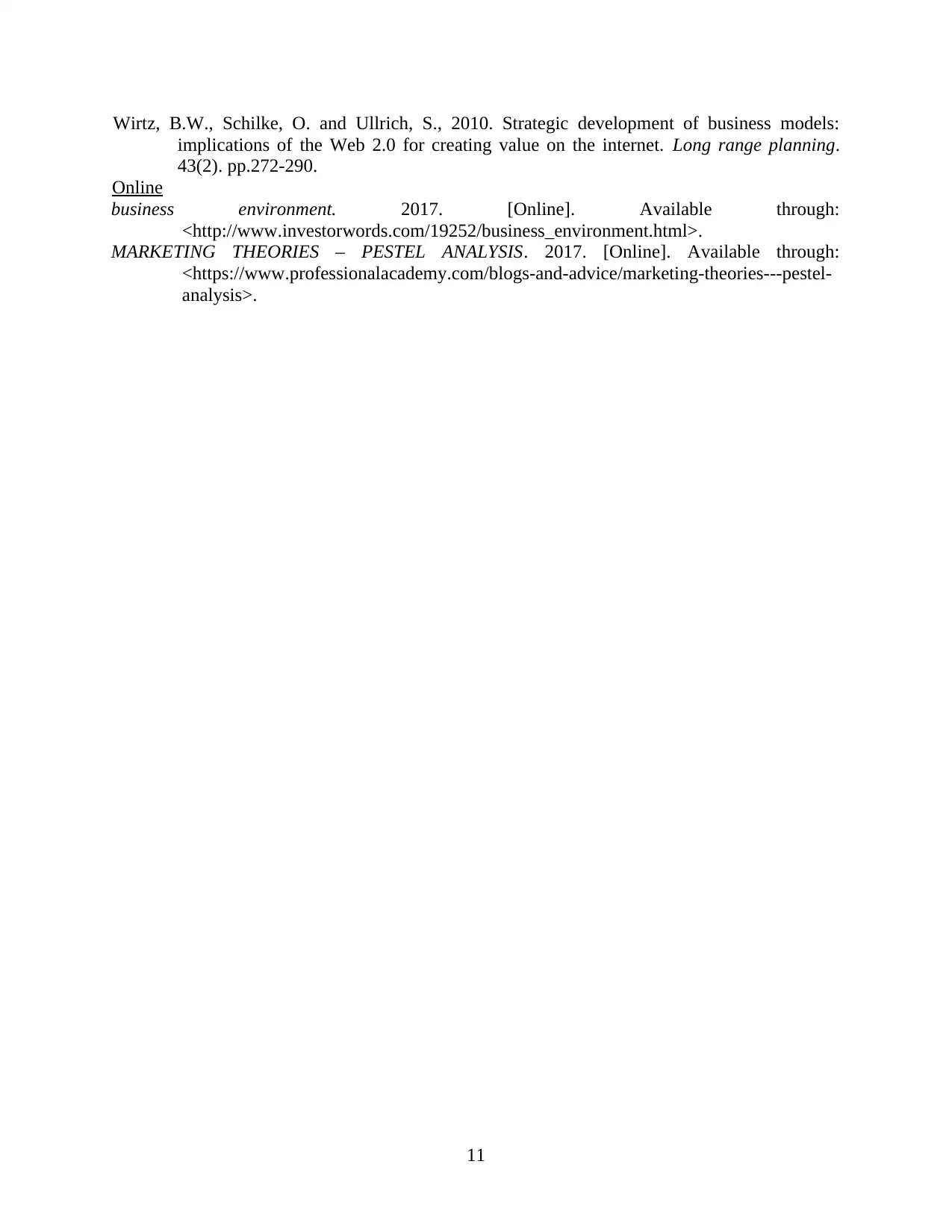
Wirtz, B.W., Schilke, O. and Ullrich, S., 2010. Strategic development of business models:
implications of the Web 2.0 for creating value on the internet. Long range planning.
43(2). pp.272-290.
Online
business environment. 2017. [Online]. Available through:
<http://www.investorwords.com/19252/business_environment.html>.
MARKETING THEORIES – PESTEL ANALYSIS. 2017. [Online]. Available through:
<https://www.professionalacademy.com/blogs-and-advice/marketing-theories---pestel-
analysis>.
11
implications of the Web 2.0 for creating value on the internet. Long range planning.
43(2). pp.272-290.
Online
business environment. 2017. [Online]. Available through:
<http://www.investorwords.com/19252/business_environment.html>.
MARKETING THEORIES – PESTEL ANALYSIS. 2017. [Online]. Available through:
<https://www.professionalacademy.com/blogs-and-advice/marketing-theories---pestel-
analysis>.
11
1 out of 13
Related Documents
Your All-in-One AI-Powered Toolkit for Academic Success.
+13062052269
info@desklib.com
Available 24*7 on WhatsApp / Email
![[object Object]](/_next/static/media/star-bottom.7253800d.svg)
Unlock your academic potential
© 2024 | Zucol Services PVT LTD | All rights reserved.





